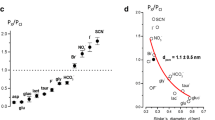Abstract
Chloride channels are expressed ubiquitously in different cells. However, the activation and roles of volume-activated chloride channels under normal isotonic conditions are not clarified, especially in lymphatic cells. In this study, the activation of basal and volume-activated chloride currents and their roles in maintenance of basal cell volume under isotonic conditions were investigated in human acute lymphoblastic leukemia Molt4 cells. The patch-clamp technique and time-lapse image analysis were employed to record whole-cell currents and cell volume changes. Under isotonic conditions, a basal chloride current was recorded. The current was weakly outward-rectified and volume-sensitive and was not inactivated obviously in the observation period. A 47% hypertonic bath solution and the chloride channel blockers NPPB and tamoxifen suppressed the current. Exposure of cells to 47% hypotonic bath solution activated further the basal current. The hypotonicity-activated current possessed properties similar to those of the basal current and was inhibited by NPPB, tamoxifen, ATP and hypertonic bath solution. Furthermore, extracellular hypotonic challenges swelled the cells and induced a regulatory volume decrease (RVD). Extracellular applications of NPPB, tamoxifen and ATP swelled the cells under isotonic conditions and inhibited the RVD induced by hypotonic cell swelling. The results suggest that some volume-activated chloride channels are activated under isotonic conditions, resulting in the appearance of the basal chloride current, which plays an important role in the maintenance of basal cell volume in lymphoblastic leukemia cells. Chloride channels can be activated further to induce a regulatory volume recovery when cells are swollen.






Similar content being viewed by others
References
Bell PD, Komlosi P, Zhang ZR (2009) ATP as a mediator of macula densa cell signalling. Purinergic Signal 5:461–471
Chang QZ, Hu DH, Chen M et al (2006) Neuroprotection of chloride channel blockers against NMDA-induced apoptosis of cultured rat hippocampal neurons. Nan Fang Yi Ke Da Xue Xue Bao 26:158–161
Chen L, Wang L, Zhu L et al (2002) Cell cycle-dependent expression of volume-activated chloride currents in nasopharyngeal carcinoma cells. Am J Physiol Cell Physiol 283:C1313–C1323
Chen LX, Zhu LY, Jacob TJ et al (2007) Roles of volume-activated Cl− currents and regulatory volume decrease in the cell cycle and proliferation in nasopharyngeal carcinoma cells. Cell Prolif 40:253–267
d’Anglemont de Tassigny A, Berdeaux A, Souktani R et al (2008) The volume-sensitive chloride channel inhibitors prevent both contractile dysfunction and apoptosis induced by doxorubicin through PI3kinase, Akt and Erk 1/2. Eur J Heart Fail 10:39–46
Duan D, Winter C, Cowley S et al (1997) Molecular identification of a volume-regulated chloride channel. Nature 390:417–421
Dutta AK, Sabirov RZ, Uramoto H et al (2004) Role of ATP-conductive anion channel in ATP release from neonatal rat cardiomyocytes in ischaemic or hypoxic conditions. J Physiol 559:799–812
Guan YY, Wang GL, Zhou JG (2006) The ClC-3 Cl− channel in cell volume regulation, proliferation and apoptosis in vascular smooth muscle cells. Trends Pharmacol Sci 27:290–296
He QF, Wang LW, Mao JW et al (2004) Activation of chloride current and decrease of cell volume by ATP in nasopharyngeal carcinoma cells. Sheng Li Xue Bao 56:691–696
Jentsch TJ, Valentin S, Frank W et al (2002) Molecular structure and physiological function of chloride channels. Physiol Rev 82:503–568
Lang F, Busch GL, Ritter M et al (1998) Functional significance of cell volume regulatory mechanisms. Physiol Rev 78:247–306
Lang F, Foller M, Lang K et al (2007) Cell volume regulatory ion channels in cell proliferation and cell death. Methods Enzymol 428:209–225
Lazarowski ER, Boucher RC, Harden TK (2000) Constitutive release of ATP and evidence for major contribution of ecto-nucleotide pyrophosphatase and nucleoside diphosphokinase to extracellular nucleotide concentrations. J Biol Chem 275:31061–31068
Liu HT, Toychiev AH, Takahashi N et al (2008) Maxi-anion channel as a candidate pathway for osmosensitive ATP release from mouse astrocytes in primary culture. Cell Res 18:558–565
Mao J, Wang L, Fan A et al (2007) Blockage of volume-activated chloride channels inhibits migration of nasopharyngeal carcinoma cells. Cell Physiol Biochem 19:249–258
Mao J, Chen L, Xu B et al (2009) Volume-activated chloride channels contribute to cell-cycle-dependent regulation of HeLa cell migration. Biochem Pharmacol 77:159–168
Praetorius HA, Leipziger J (2009) ATP release from non-excitable cells. Purinergic Signal 5:433–446
Pusch M, Neher E (1988) Rates of diffusional exchange between small cells and a measuring patch pipette. Pflugers Arch 411:204–211
Sabirov RZ, Okada Y (2005) ATP release via anion channels. Purinergic Signal 1:311–328
Shen MR, Droogmans G, Eggermont J et al (2000) Differential expression of volume-regulated anion channels during cell cycle progression of human cervical cancer cells. J Physiol 529:385–394
Shirley DG, Vekaria RM, Sevigny J (2009) Ectonucleotidases in the kidney. Purinergic Signal 5:501–511
Wang GL, Wang XR, Lin MJ et al (2002a) Deficiency in ClC-3 chloride channels prevents rat aortic smooth muscle cell proliferation. Circ Res 91:E28–E32
Wang L, Chen L, Zhu L et al (2002b) Regulatory volume decrease is actively modulated during the cell cycle. J Cell Physiol 193:110–119
Wondergem R, Gong W, Monen SH et al (2001) Blocking swelling-activated chloride current inhibits mouse liver cell proliferation. J Physiol 532:661–672
Xiong D, Heyman NS, Airey J et al (2010) Cardiac-specific, inducible ClC-3 gene deletion eliminates native volume-sensitive chloride channels and produces myocardial hypertrophy in adult mice. J Mol Cell Cardiol 48:211–219
Zhou JG, Ren JL, Qiu QY et al (2005) Regulation of intracellular Cl− concentration through volume-regulated ClC-3 chloride channels in A10 vascular smooth muscle cells. J Biol Chem 280:7301–7308
Zuo W, Zhu L, Bai Z et al (2009) Chloride channels involve in hydrogen peroxide-induced apoptosis of PC12 cells. Biochem Biophys Res Commun 387:666–670
Acknowledgments
This work was supported by the National Natural Science Foundation of China (30771106, 30870567, 30871267, 90913020 and U0932004).
Author information
Authors and Affiliations
Corresponding authors
Additional information
Guozhen Cao and Wanhong Zuo contributed equally to the work.
Rights and permissions
About this article
Cite this article
Cao, G., Zuo, W., Fan, A. et al. Volume-Sensitive Chloride Channels are Involved in Maintenance of Basal Cell Volume in Human Acute Lymphoblastic Leukemia Cells. J Membrane Biol 240, 111–119 (2011). https://doi.org/10.1007/s00232-011-9349-7
Received:
Accepted:
Published:
Issue Date:
DOI: https://doi.org/10.1007/s00232-011-9349-7




